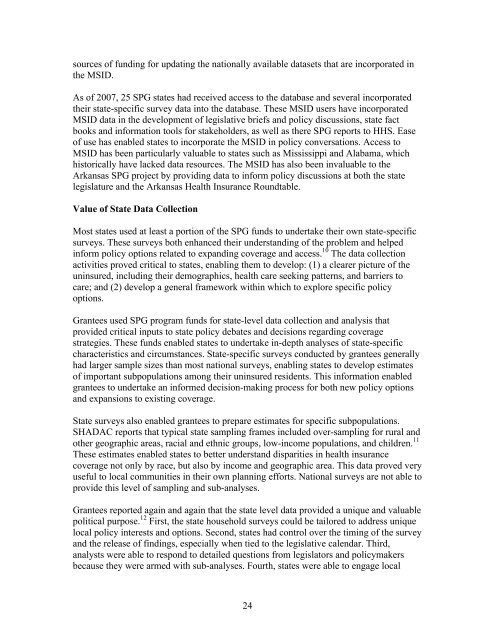SPG synthesis report - State Coverage Initiatives
SPG synthesis report - State Coverage Initiatives
SPG synthesis report - State Coverage Initiatives
Create successful ePaper yourself
Turn your PDF publications into a flip-book with our unique Google optimized e-Paper software.
sources of funding for updating the nationally available datasets that are incorporated in<br />
the MSID.<br />
As of 2007, 25 <strong>SPG</strong> states had received access to the database and several incorporated<br />
their state-specific survey data into the database. These MSID users have incorporated<br />
MSID data in the development of legislative briefs and policy discussions, state fact<br />
books and information tools for stakeholders, as well as there <strong>SPG</strong> <strong>report</strong>s to HHS. Ease<br />
of use has enabled states to incorporate the MSID in policy conversations. Access to<br />
MSID has been particularly valuable to states such as Mississippi and Alabama, which<br />
historically have lacked data resources. The MSID has also been invaluable to the<br />
Arkansas <strong>SPG</strong> project by providing data to inform policy discussions at both the state<br />
legislature and the Arkansas Health Insurance Roundtable.<br />
Value of <strong>State</strong> Data Collection<br />
Most states used at least a portion of the <strong>SPG</strong> funds to undertake their own state-specific<br />
surveys. These surveys both enhanced their understanding of the problem and helped<br />
inform policy options related to expanding coverage and access. 10 The data collection<br />
activities proved critical to states, enabling them to develop: (1) a clearer picture of the<br />
uninsured, including their demographics, health care seeking patterns, and barriers to<br />
care; and (2) develop a general framework within which to explore specific policy<br />
options.<br />
Grantees used <strong>SPG</strong> program funds for state-level data collection and analysis that<br />
provided critical inputs to state policy debates and decisions regarding coverage<br />
strategies. These funds enabled states to undertake in-depth analyses of state-specific<br />
characteristics and circumstances. <strong>State</strong>-specific surveys conducted by grantees generally<br />
had larger sample sizes than most national surveys, enabling states to develop estimates<br />
of important subpopulations among their uninsured residents. This information enabled<br />
grantees to undertake an informed decision-making process for both new policy options<br />
and expansions to existing coverage.<br />
<strong>State</strong> surveys also enabled grantees to prepare estimates for specific subpopulations.<br />
SHADAC <strong>report</strong>s that typical state sampling frames included over-sampling for rural and<br />
other geographic areas, racial and ethnic groups, low-income populations, and children. 11<br />
These estimates enabled states to better understand disparities in health insurance<br />
coverage not only by race, but also by income and geographic area. This data proved very<br />
useful to local communities in their own planning efforts. National surveys are not able to<br />
provide this level of sampling and sub-analyses.<br />
Grantees <strong>report</strong>ed again and again that the state level data provided a unique and valuable<br />
political purpose. 12 First, the state household surveys could be tailored to address unique<br />
local policy interests and options. Second, states had control over the timing of the survey<br />
and the release of findings, especially when tied to the legislative calendar. Third,<br />
analysts were able to respond to detailed questions from legislators and policymakers<br />
because they were armed with sub-analyses. Fourth, states were able to engage local<br />
24






